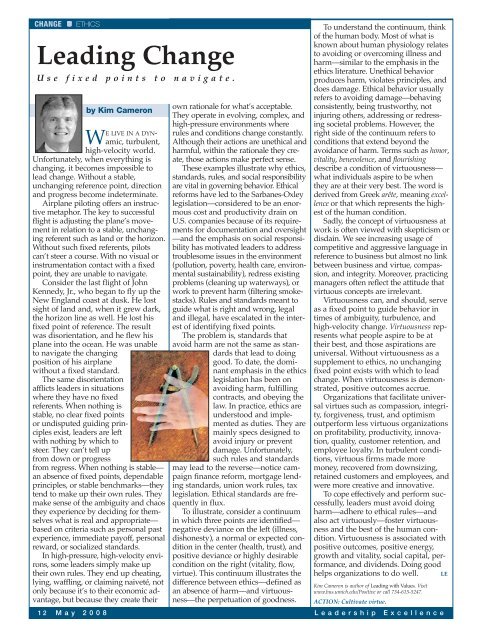Read More - Zenger Folkman
Read More - Zenger Folkman
Read More - Zenger Folkman
- No tags were found...
Create successful ePaper yourself
Turn your PDF publications into a flip-book with our unique Google optimized e-Paper software.
CHANGEETHICSLeading ChangeUse fixed points to navigate.by Kim CameronWE LIVE IN A DYNamic,turbulent,high-velocity world.Unfortunately, when everything ischanging, it becomes impossible tolead change. Without a stable,unchanging reference point, directionand progress become indeterminate.Airplane piloting offers an instructivemetaphor. The key to successfulflight is adjusting the plane’s movementin relation to a stable, unchangingreferent such as land or the horizon.Without such fixed referents, pilotscan’t steer a course. With no visual orinstrumentation contact with a fixedpoint, they are unable to navigate.Consider the last flight of JohnKennedy, Jr., who began to fly up theNew England coast at dusk. He lostsight of land and, when it grew dark,the horizon line as well. He lost hisfixed point of reference. The resultwas disorientation, and he flew hisplane into the ocean. He was unableto navigate the changingposition of his airplanewithout a fixed standard.The same disorientationafflicts leaders in situationswhere they have no fixedreferents. When nothing isstable, no clear fixed pointsor undisputed guiding principlesexist, leaders are leftwith nothing by which tosteer. They can’t tell upfrom down or progressfrom regress. When nothing is stable—an absence of fixed points, dependableprinciples, or stable benchmarks—theytend to make up their own rules. Theymake sense of the ambiguity and chaosthey experience by deciding for themselveswhat is real and appropriate—based on criteria such as personal pastexperience, immediate payoff, personalreward, or socialized standards.In high-pressure, high-velocity environs,some leaders simply make uptheir own rules. They end up cheating,lying, waffling, or claiming naiveté, notonly because it’s to their economic advantage,but because they create theirown rationale for what’s acceptable.They operate in evolving, complex, andhigh-pressure environments whererules and conditions change constantly.Although their actions are unethical andharmful, within the rationale they create,those actions make perfect sense.These examples illustrate why ethics,standards, rules, and social responsibilityare vital in governing behavior. Ethicalreforms have led to the Sarbanes-Oxleylegislation—considered to be an enormouscost and productivity drain onU.S. companies because of its requirementsfor documentation and oversight—and the emphasis on social responsibilityhas motivated leaders to addresstroublesome issues in the environment(pollution, poverty, health care, environmentalsustainability), redress existingproblems (cleaning up waterways), orwork to prevent harm (filtering smokestacks).Rules and standards meant toguide what is right and wrong, legaland illegal, have escalated in the interestof identifying fixed points.The problem is, standards thatavoid harm are not the same as standardsthat lead to doinggood. To date, the dominantemphasis in the ethicslegislation has been onavoiding harm, fulfillingcontracts, and obeying thelaw. In practice, ethics areunderstood and implementedas duties. They aremainly specs designed toavoid injury or preventdamage. Unfortunately,such rules and standardsmay lead to the reverse—notice campaignfinance reform, mortgage lendingstandards, union work rules, taxlegislation. Ethical standards are frequentlyin flux.To illustrate, consider a continuumin which three points are identified—negative deviance on the left (illness,dishonesty), a normal or expected conditionin the center (health, trust), andpositive deviance or highly desirablecondition on the right (vitality, flow,virtue). This continuum illustrates thedifference between ethics—defined asan absence of harm—and virtuousness—theperpetuation of goodness.To understand the continuum, thinkof the human body. Most of what isknown about human physiology relatesto avoiding or overcoming illness andharm—similar to the emphasis in theethics literature. Unethical behaviorproduces harm, violates principles, anddoes damage. Ethical behavior usuallyrefers to avoiding damage—behavingconsistently, being trustworthy, notinjuring others, addressing or redressingsocietal problems. However, theright side of the continuum refers toconditions that extend beyond theavoidance of harm. Terms such as honor,vitality, benevolence, and flourishingdescribe a condition of virtuousness—what individuals aspire to be whenthey are at their very best. The word isderived from Greek arête, meaning excellenceor that which represents the highestof the human condition.Sadly, the concept of virtuousness atwork is often viewed with skepticism ordisdain. We see increasing usage ofcompetitive and aggressive language inreference to business but almost no linkbetween business and virtue, compassion,and integrity. <strong>More</strong>over, practicingmanagers often reflect the attitude thatvirtuous concepts are irrelevant.Virtuousness can, and should, serveas a fixed point to guide behavior intimes of ambiguity, turbulence, andhigh-velocity change. Virtuousness representswhat people aspire to be attheir best, and those aspirations areuniversal. Without virtuousness as asupplement to ethics, no unchangingfixed point exists with which to leadchange. When virtuousness is demonstrated,positive outcomes accrue.Organizations that facilitate universalvirtues such as compassion, integrity,forgiveness, trust, and optimismoutperform less virtuous organizationson profitability, productivity, innovation,quality, customer retention, andemployee loyalty. In turbulent conditions,virtuous firms made moremoney, recovered from downsizing,retained customers and employees, andwere more creative and innovative.To cope effectively and perform successfully,leaders must avoid doingharm—adhere to ethical rules—andalso act virtuously—foster virtuousnessand the best of the human condition.Virtuousness is associated withpositive outcomes, positive energy,growth and vitality, social capital, performance,and dividends. Doing goodhelps organizations to do well. LEKim Cameron is author of Leading with Values. Visitwww.bus.umich.edu/Positive or call 734-615-5247.ACTION: Cultivate virtue.12 May 2008 Leadership Excellence






